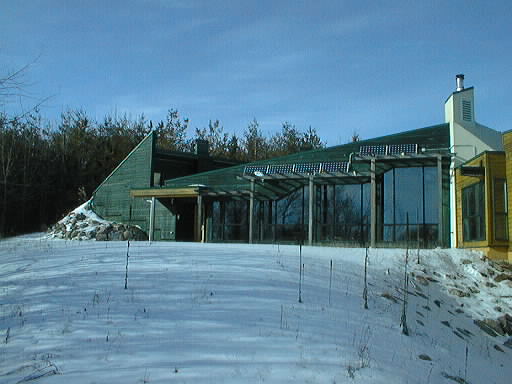
Burrows Earth Residence
Student Research Team:
Andre Bohren, Dan Vandebilt, Lachlan Oddie, John Russell, Anthony Muscat
(Home) (Background) (Hypotheses) (Methodology) (Analysis) (Conclusions) (References).
Abstract
Burrows Residence, a passive solar camp residence in Waterloo, Ontario, Canada by architect Charles Simon and was completed in 1995
This study will examine the heating effectiveness of the building in a YMCA camp residence heated solely by passive solar gain and wood-burning masonry furnace. This residence by Charles Simon was designed to comfortably accommodate 40 people in 8 bedrooms clustered behind a central living space. This living space contains the south-facing glazing and wood burning furnace. The residence is ideally located on a south-facing hill, bermed on the north wall and surrounded by coniferous tree plantings.
Employing a diverse number of research instruments in the form of group interviews
with the buildings' camp director, informal interviews with the designer,
and the use of temperature and relative humidity sensors and dataloggers and
daylighting intstruments, data was collected to document the buildings' performance
during the second week of March 1998. Results showed that outdoor temperatures
fluctuating from daily highs of 2-15 degrees C to night time lows dropping to
-15 C with an interior temp remaining relatively stable between 17 and
24 C. Intentions of the architect were to provide a comfortable living
space in a cold northern climate solely using renewable resources.
The report is broken into five main sections.
The first section provides Background information that describes the setting and climate of Paradise Lake, Ontario.
In the Hypotheses section, you'll find a description of the questions the study attempted to answer.
The next section, Methodology, describes the process used to conduct the study.
In the Analysis section findings are presented.
In the following section, Conclusions, the author offers his impression of the findings from the study and presents some ideas for further investigation.
A list of References is also included.
(Home) (Background)
(Hypotheses) (Methodology)
(Analysis) (Conclusions)
(References).
![]()
![]()
![]()
![]()